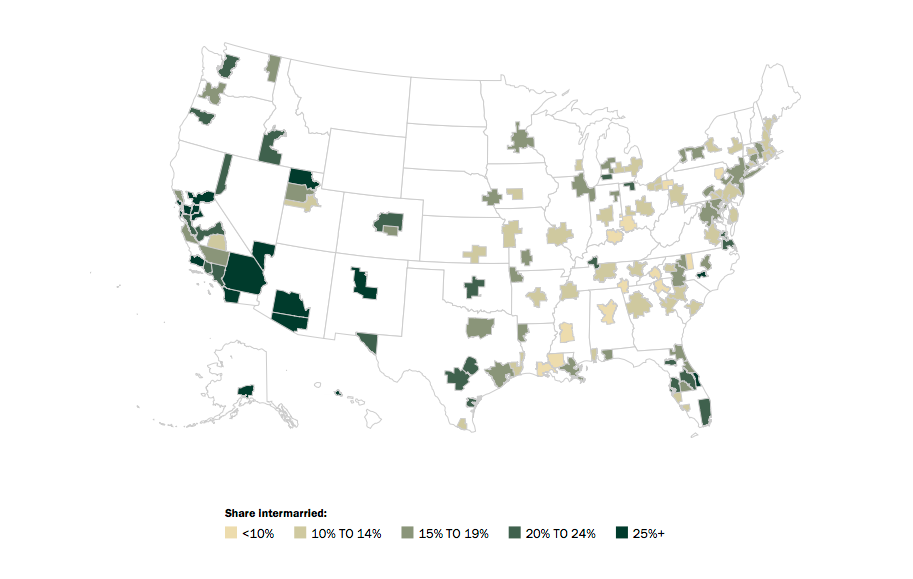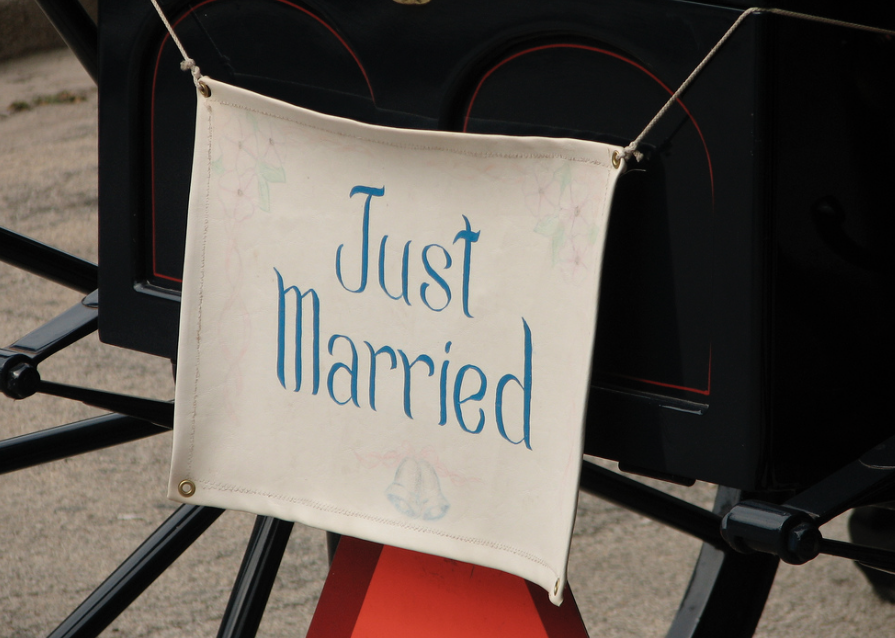Marriage between partners of different racial or ethnic backgrounds has been used as a measure of progress since the landmark Loving v. Virginia case 50 years ago struck down a state ban on interracial marriage. Since then, rates of intermarriage have steadily crept upward; by 2015, 17 percent of newlyweds were couples with different backgrounds, according to a new report from the Pew Research Center.
Breaking it down by metropolitan area, some trends emerge. Cities in the western part of the U.S., for example, have some of the highest rates of intermarriage among newlyweds. Asian and Hispanic people are much more likely than white or black people to intermarry, but the rate of intermarriage among black people is the fastest growing in recent years. And intermarriage is more common in metropolitan areas than rural areas, where both attitudes and demographics are markedly different.
The report, authored by Gretchen Livingston and Anna Brown, also cites changing attitudes nationally. "The growth in intermarriage has coincided with shifting societal norms as Americans have become more accepting of marriages involving spouses of different races and ethnicities, even within their own families," they write.
But diversity and changing attitudes don't necessarily mean higher rates of intermarriage. Just look at Houston.
The Houston metropolitan area is recognized as the most diverse in the country. Eighty-two percent of Kinder Houston Area Survey respondents said they would approve of a family member marrying someone of a different background, back in 2011, the last time that question was asked. Eleven percent said ethnicity made no difference at all. But only 19 percent of Houston-area marriages between 2011 and 2015 were intermarriages, according to the Pew report. That puts Houston below dozens of metropolitan areas, including Miami, Los Angeles, Las Vegas, Austin and other major Sun Belt cities.
Honolulu tops the list, with 42 percent of recent marriages happening between partners of different racial or ethnic backgrounds. Places like Albuquerque, San Diego and Sacramento are all in the high 20s. Rates can also be broken down by specific groups.
So, for example, 34 percent of recently married white people in Honolulu were part of an interracial or interethnic marriage. In Los Angeles, 30 percent of black people married between 2011 and 2015 intermarried. Tampa and Denver both saw the highest percentage of intermarried Hispanic newlyweds at 36 percent. And Chicago's Asian community was the most likely to intermarry with 35 percent of Asian newlyweds intermarrying.

Infographic: Share of newlyweds with a spouse of a different race or ethnicity, by metropolitan area (2011-2015)
Pew Research Center
Houston's rate of intermarriage may be relatively low because its different racial/ethnic communities are so large, argues Jenifer Bratter, a sociologist at Rice University's Kinder Institute for Urban Research. In other words, the communities are large enough that it's relatively easy to marry within the racial/ethnic group.
"Houston is this place where you have really established communities, and with established communities, you have marriage markets," said Jenifer Bratter, a sociologist at Rice University who studies interracial marriage and racial identity. "There are probably numerically more mixed couples and kids here but in terms of rates, I wouldn't anticipate that it would be higher than other places."
Some diversity allows for the opportunity of intermarriage but in certain cases a substantial enough population means there's more opportunity to marry someone of the same background. The smallest of Houston's four major ethnicities -- its Asian population -- also has the highest rate of intermarriage with 22 percent. The white and Hispanic population, meanwhile, marry outside their respective communities at an equal rate of 19 percent. Black people are the least likely to intermarry in Houston, with just 11 percent marrying someone of a different race.
Which demonstrates the next crucial point to understanding these numbers: the context of the metropolitan area matters as well. Though Houston is a diverse city, it's also a historically segregated city where deep divisions remain evident in the landscape.
"There's a huge role played by just the numbers game and the kind of way in which groups are distributed," said Bratter. "It matters to the opportunities for that kind of contact. I think our cultural story doesn’t do a good job of acknowledging that sort of reality. The larger narrative around intermarriage is that it's driven by cultural shifts," she said, citing the Loving case and the belief that younger people will be more open.
"I think it's true people are more open in terms of attitudes; people are generally pretty resistant to saying that they oppose intermarriage. But there's other work that shows if you ask someone how would you feel about someone in your family or yourself (intermarrying), there’s more resistance," said Bratter.
Researchers have documented this phenomenon, describing it as a gap between global and personal attitudes. Indeed, in Houston, despite the reported overwhelming support for intermarriage, only 41 percent of respondents said in 2016 that they had ever been in a romantic relationship with someone of a different background.

